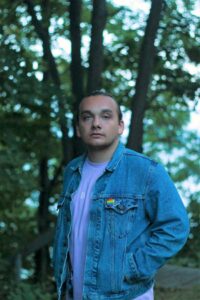Anishinaabe filmmaker returns home to Nbisiing traditional territory

– Photo by Katie Couchie
By Rick Garrick
NIPISSING FIRST NATION — Nipissing filmmaker Cole Forrest focused on his return to his community during the coronavirus disease 2019 (COVID-19) pandemic and his connection to the water while creating his recently released film: Nbisiing.
The five-minute documentary film was one of seven films released on Oct. 13 on the National Film Board’s The Curve website, a collection of animation, documentary and digital storytelling projects that give voice to those touched by the pandemic.
“This film is kind of like a documentation of me coming back to my community and sort of going deeper with my connection to it; connection to the water, the land, all the pieces of the community that I’ve always been around but I haven’t really explored in this way,” says Forrest, writer and director of Nbisiing, Nipissing citizen and George Brown College Video Design and Production graduate. “Literally all of my family is here, all of my partner’s family is here. If there was a way for me to be in this really weird space with pandemic, I wanted to be in my community.”
Forrest decided to make the film while he was down by Lake Nipissing after he and his partner moved back in June from Toronto, where they had been stuck in their apartment for three months due to COVID-19.

“That image of putting my hands into the water (in the film), that was partially just something I had been thinking about, just something simple like putting your hands in the water — it feels so good,” Forrest says. “It feels so good to connect with your community in that way. I wanted to show that.”
Forrest says his partner’s uncle shared some of the history of Lake Nipissing and its islands with him while they were boating around the lake for the film.
“And when I was on one of the islands, part of that process was when I found my first Eagle Feather,” Forrest says. “It just made me feel this is what I’m supposed to be doing — I’m meant to make this film.”
Forrest says he was new to making documentary films, so he credits his mentor Nadine Pequeneza and producer Justine Pimlott for helping him with navigating the documentary film process.
“Justine and Nadine really helped me navigate how to be expressive and be experimental and be interesting in documentary,” Forrest says. “And also that process was learning how to be vulnerable — I think that’s a part of being creative, is learning to give a part of yourself in the process.”
Forrest says his experience of growing up on Lake Nipissing is ingrained in his DNA.
“I didn’t really understand what I had until I moved to Toronto,” Forrest says. “I’ve gone for how many boat rides out on the lake or how many times walking on the lake in the winter. Being here now and having made this film on the lake, it’s made me appreciate how much of a privilege it is to have this lake and how important it is to protect it and to make work about it and to advocate for how important it is.”
Forrest appreciates the response from his community about the film.
“A lot of people have said, ‘It captures what the lake makes them feel like,’” Forrest says. “And that makes me emotional. When I hear other people from my community say things like that it makes me feel like I’m really a part of this community.”
Forrest’s film is available on the National Film Board of Canada website.


